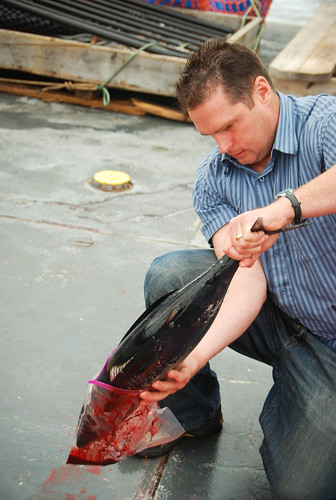Mainstream News has become the Band on the Titanic....
Alternative, Breaking, World News that Reports what the Mainstream Media Ignores.
Welcome to "The Honest Intelligence"
Please see Copyright information at bottom of page...
*Just In* More US tuna contaminated — Study: Entire Food Web “Including Humans” May Be Affected as Fukushima Radionuclides Spread to West Coast
Title: Assessment and characterization of radionuclide concentrations from the Fukushima Reactor release in the plankton and nekton communities of the Northern California Current
Delvan Neville (Oregon St. Univ.), Richard D. Brodeur (NOAA), A. Jason Phillips (OSU) and Kathryn Higley (OSU)
 |
| Fisheries researcher Jason Phillips bleeds a just-caught albacore tuna
into a collection bag. The blood, along with all of the animal's
skeletal, organ and muscle tissue, will be tested for traces of
radiation. Photo by Cisco Werner, Southwest Fisheries Science Center. |
The incident at the Fukushima Daiichi nuclear plant released a substantial radioactive contamination into the environment. With the predominant wind and current flow in this part of the North Pacific, these radionuclides will gradually spread to the US West Coast waters after a suitable period of time, with the possibility of affecting food quality throughout the food web (including humans). In addition to the passive transport by currents and winds, the migratory pathways of large pelagic fish extend from Japan to the Northern California Current. These organisms can serve as transport vectors for these nuclides, especially given their capacity to concentrate radionuclides from surrounding waters and prey. [...] By predicting the radio-biologic stress (if any) for a managed species as more Fukushima-related radionuclides are uptaken, appropriate action may be taken before significant population effects have occurred. Determination of natural background concentrations and high quality transport models produced from these data also aid in management in the event of a future accidental release, and in regulating safe activity releases.
Oregon State University Press Release, Oct. 24, 2012:
[...] Phillips spent this summer collecting more fish at sea, off Oregon and Washington, as well as from scientists, fishermen and other sources along the West Coast. [...] As more fish were tested, the results were consistent with the initial findings: No Cs-134 in fish caught before the disaster, but traces of the isotope in a significant number of fish caught since. “This is what we’ve seen after testing about 70 pounds of tuna,” Neville said. [...]
No mention of the actual cesium levels detected in the tuna, only that it’s safe to eat.
Source

